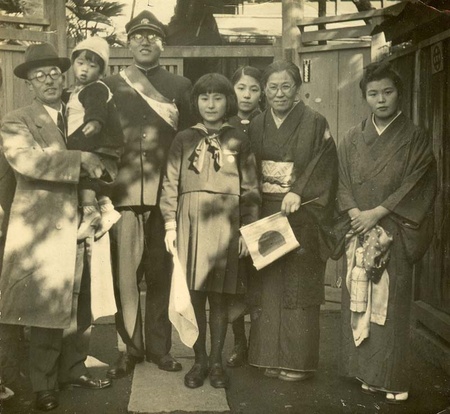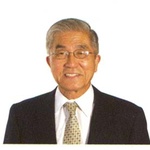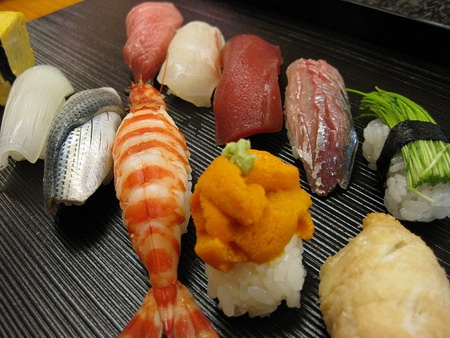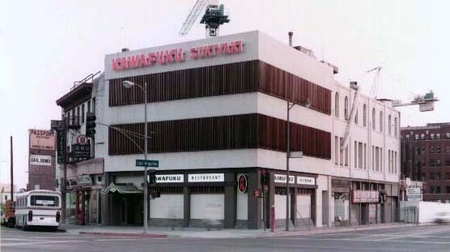In one of our weekly powwows at Maryknoll, I asked my friends whether anyone knew how and when sushi came to Los Angeles. Kō Hoshizaki said that the right person to answer my questions was Mr. Noritoshi Kanai, the President of Mutual Trading Company (MTC) in downtown Los Angeles.1
“He has even written a book about it,” Kō said.
So I lost no time in asking him for an introduction, something he promptly arranged, and I was thus able to meet that almost legendary man. At 86, Kanai-san, tall and imposing, is still the very effective head of MTC, the business he acquired years after Kō’s father retired.2
Kanai-san was born in Japan in 1923, the third son in a Gumma Prefecture family. In 1941, he entered Tokyo Shoka (now Hitotsubashi) University, to prepare for a career in foreign trade. Like most students in his age cohort, he too was forced to serve in the Japanese Army, in 1943. He ended up in Burma, as a quartermaster officer.
When Japan finally surrendered, Kanai managed to return to his native land. Though disenchanted with life, he went back to school and graduated. Always wanting to be his own man, he started a few businesses, all of which failed, and he ended up saddled with an immense debt. To get out of it, he began manufacturing high-power motors for trucks, and got out of the hole in only two years.
In 1952, he entered the food industry with a friend of his mother, Mr. Ishii. They became the reps of MTC in Japan. When Mr. Hoshizaki the elder was ready to retire, Richard Inaba, owner of a trading company in Northern California, was asked to join MTC as President. Years later Mr. Ishii bought MTC and became its third president. But he suffered a cerebral hemorrhage, and in 1964, Kanai-san immigrated to America with his family, and took the reins of MTC.3
By the time he came to the United States, although the odious rancor against the Japanese had considerably subsided, there was not much of a demand for Japanese delicacies. Kanai-san began hunting for “something delicious” that could please American tastes.
His first venture was importing a Japanese specialty, Harvest Cookies, the coconut biscuits made by Tohato Kaisha. Crunchy, tasty and just sweet enough for the American palate, the cookies had a great potential. To introduce the product, he traveled all over America offering samples to potential clients and to the public; and he managed to create a very good following. With the yen at 360 per dollar, the venture seemed destined to attain great success, and Kanai-san thought he had finally made it. The fun lasted for just about 3 years, after which his sales suddenly plummeted. Upon looking for the reason, he discovered that in China or South Korea, somebody had copied the product, and was selling it at a considerably lower price.
With a typical shikata ga nai attitude, he looked for a more lasting venture. The younger Japanese were fleeing to Tokyo from other areas. But living space there was at a premium, and many housewives had to get a job outside their homes. Thus, modern couples needed far more convenient households, and very utilitarian kitchenwares.
With that in mind, Kanai got a license to export American home wares to Japan. He traveled to a houseware exhibit in Chicago, searching for ideal things to sell abroad. While in Chicago, he met Harry Goldberg, a Jewish fellow who seemed to possess an excellent business sense. Goldberg had already retired after “making his pile.”
In his frequent talks with Kanai-san, Harry always hammered on the idea that success comes when an entrepreneur detects a public need, jumps to serve it, and does that in the best possible way. And, he suggested to Mr. Kanai, to hire him at commission, and let him share his talent for business. Mr. Kanai obliged, and that started a very interesting partnership. They traveled together to Asia searching for trade opportunities. The trip ended in Japan, where MTC had an office.
In Japan, Kanai-san introduced his friend to Edomae sushi, at Shinozukesushi, and the fellow fell in love with it. After a week, the two friends decided to return to America. Before leaving Japan, Kanai-san was presented with a hefty bill from that sushi bar, which Harry had visited daily. The tab was over ¥ 12,000, and Kanai-san obliged again.
After their return, they held some debriefing sessions on their travel experiences, hoping to find what could offer the best opportunities for Mutual Trading. Harry suggested:
“Sushi…!”
“What a crazy idea,” thought Kanai-san. How would Americans ever learn to eat raw fish? Goldberg enlightened Kanai about how Jews, Italians, Spanish, people from other Mediterranean and Southern European countries, and their descendants in America, fancied gefilte fish, caviar, roe, squid, octopus, Spanish tapas and similar delicacies. Kanai-san was still as cool to the idea as a slice of hard frozen albacore.
Harry argued that, however good any familiar product might be, after it landed well in the market, someone else would imitate it. That was the most common character of business. But sushi, being at the heart of Japanese culture, would be difficult to imitate, because hardly anyone in America knew that culture. Precisely for that reason, it would be ideal for anyone in search of success. Moreover, for success, one had to be willing to jump ahead of the pack.
A favorable factor for jumping ahead was the social clime of the times. Disenchanted with American traditions, the younger sets had rebelled against the old cultural mores, and were looking to the “Orient” for new answers to their needs. The herd was exploring macrobiotics, tofu, alternative consciousness states, even Zen. Volkswagen, Honda and Datsun were dislocating the American gas-guzzling car industry. What an enticing field!
For three days in a row the two friends hashed out the idea. Where to start? How to launch the enterprise? Should they choose a big or a small facility? What to offer: nigiri, maki-sushi? Who’d supply the trusted kinds of fish? The small open bar was ideal; people would see fresh sushi being prepared, and what they’d be eating. Of course MTC would provide all the requirements of the sushi culture. And, they had to help create the initial serving sushi outlet. So, Kanai-san approached Mr. Nakajima, of the Kawafuku Restaurant in Little Tokyo; in his enticing proposal, you could hear echoes of Harry Goldberg’s business philosophy.
“It is enormously popular in Tokyo; it will become just as popular in Little Tokyo,” said Kanai. “We have here a population familiar with these delicacies. Success is assured!” Mr. Nakajima doubted very much that anyone could succeed in America with sushi.
“For about two months, I pestered him steadily,” Kanai-san remembers. “Every couple of weeks I‘d go there with the same story.”Finally Nakajima san agreed to a try. He would open a small sushi bar.
Notes:
1. Mutual Trading Company (MTC) has branches in several cities of the United States, including New York, and portrays itself as the Premier Japanese Food Service ; Japanese Foodservice Trade Pioneer and Global Trendsetter. Bringing the Flavors of Japan to the People of the World. See MTC’s home page at www.lamtc.com
2. MTC was originally founded by Mr. Sadagoro Hoshizaki, Kō’s father, in 1926.
3. Personal interview with K. Hoshizaki. Also, JBA News, September 2004.
*This story first appeared in the East San Gabriel Valley’s Japanese Community Center’s “Newsette” in January 2009.
© 2009 Edward Moreno









